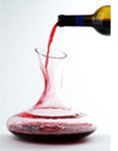Decanting is almost a ceremonial act, as it requires practice and skill. The process consists in transferring the wine from the original bottle to a container, usually made of crystal, known as decanter. It is very usual in red wines, but not very common in white ones. Two major benefits from decanting wine are the extraction of lees (formed during ageing) and the oxidation of the wine.
Two major benefits from decanting wine are the extraction of lees (formed during ageing) and the oxidation of the wine.
Oxygenation releases the aromas formed in the wines that have been bottle-aged for several years. In this case, decanting should be made just before serving the wine because the released aromas will quickly dissipate. In young red wines decanting softens the tannins (naturally rough) and should be performed two hours before the wine being served. If the wine is not rich in tannins, it should not be decanted; otherwise, the complexity of its aromas may disappear.
Decanting is an optional process that depends on personal preferences. However, it is convenient to decant a wine that has lees. When such a wine is served in the original bottle, the slightest movement will make the liquid mix with the sediment.
How to decant old wine
Before decanting, the bottle should stay upright for a day or two to let the deposit stay at the bottom. Prepare the necessary materials: bottle, candle or light bulb and decanter. You may also use a decanting basket. Open the bottle, wipe the neck and light the candle. Place the neck of the bottle over the candle and pour the liquid into the decanter. It has to be a constant and non interrupted movement. Once you see the first particles of sediment reach the neck of the bottle, immediately stop pouring the liquid. Place the bottle upright and leave it close to the decanter, in order to identify the wine you are going to drink.
How to decant young wine
Open the bottle. Pour the liquid into an appropriate container (decanter). Place the bottle close to the decanter, in order to identify the wine you are going to drink.
What if it is an emergency?
If the bottle hasn’t had time to let the sediments settle, you may use a little trick: cover the decanter’s nozzle with a thin, white cloth or a paper napkin and pour the wine into the decanter. When you start seeing signs of sediment in the cloth, stop the operation.


 How wine is made
How wine is made How to serve
How to serve





